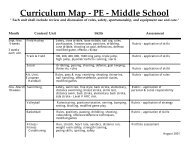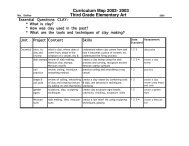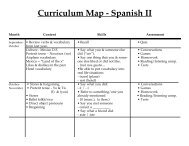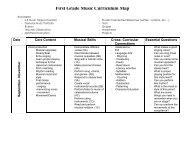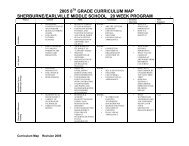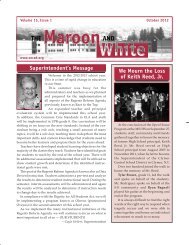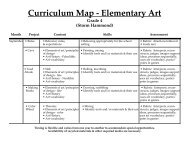Curriculum Map - AP Biology
Curriculum Map - AP Biology
Curriculum Map - AP Biology
- No tags were found...
Create successful ePaper yourself
Turn your PDF publications into a flip-book with our unique Google optimized e-Paper software.
<strong>Curriculum</strong> <strong>Map</strong> - <strong>AP</strong> <strong>Biology</strong>Month Content Skills AssessmentSeptember • Biochemistry • Recognize examples of various • lab: enzyme catalysis -- Basic Chemistry types of organic molecules. What changes rate of enzyme action?- Properties of water • Construct basic organic molecules • exam: multiple choice & essay- Versatility of carbon using molecular kits. • quizzes - lock & key model, water,- Types of organic • Describe the properties of water major classes biochemistrymolecules and carbon that make them essential • lab: proteases• Cells for living things. • lab: paperase - when [ ] charges- Prokaryotic versus • Compare various types of cells. rate changeseukaryotic • Identify cell parts under the • lab: osmosis & diffusionmicroscope.• exam: multiple choice & essay• lab: plastidsOctober • Cell Structure and • Differentiate between types of • quizzes - cell organelles, structure &Function transport. function recognition• Cell Transport and • Show the effects of solute • cell CD - cell organelles, structure &Permeability concentration on cell membranes. function recognition• Determine what types of moleculespass through a cell membranepassively.• Video History Channel - accom-• Molecular Genetics • Define and diagram DNA plishments in molecular genetics- Nucleic acid structure structure. • lab: gel electrophoresis- DNA replication • Relate gene position and structure • lab: gene transformation- Protein synthesis to that of the chromosome. • test: multiple choice/essay- Mutation • Identify sources of genetic change. • article/summary on genetic- Control of gene • Run and summarize a DNA technology - Understand processes &expression fingerprint. results of new role genetics techniques.- Molecular genetic technology • Transform a gene for ampicillin • quizzesresistance to an e.coli bacteria. • activity: protein synthesis• Genetic Update Conference• activity: paper - DNA fingerprinting
<strong>Curriculum</strong> <strong>Map</strong> - <strong>AP</strong> <strong>Biology</strong>Month Content Skills AssessmentNovember • Classical Genetics • Construct punnet squares to • lab: allele frequencies- mendelian inheritance solve genetic problems. • work sheets - genetic problem solving- probability • Complete a genetic survey. • quizzes- sex determination • Interpret how various factors • test: Multiple choice/essay- chromosomal abnormalities influence gene frequencies. • Be able to solve single trait crosses,and defect2 traits unlinked, 2 traits linked, blood- linkage type, codominant, & sex linked- epistasis problems.- polygenic inheritance- multiple alleles• Evolution • Collect evidence that evolution • lab: evidence for evolution- evidence of evolution has and is occurring. • CR butterfly activity- Darwin -”natural selection” • Restate the parts of Darwin’s • test: multiple choice/essay- selection forces theory of natural selection. • research report on- origin of life- oral presentation -December • Changes in allele frequency • Propose a theory as to the true • Quizzes• Speciation origin of life.• Origin of life• Interpret how various forcesinfluence evolution.• Classification • Identify criteria used to classify • lab: animal survey - where each- criteria for classification organisms. group is assigned a kingdom & are• 5 Kingdom Survey • Compare & contrast examples expected to create & present a power(structure & examples) & characteristics of representatives point presentation of that kingdom- monera from the various kingdoms. to the class- protist • Handle & generate observations • test: multiple choice/essay- fungus of preserved specimens. • quizzes- plant • practical: animal classification- animal
<strong>Curriculum</strong> <strong>Map</strong> - <strong>AP</strong> <strong>Biology</strong>Month Content Skills AssessmentJanuary • Photosynthesis and Respiration • Reconstruct the reactions for • Lab: photosynthetic pigment- aerobic respiration respirations and photosynthesis. separation- fermentation • Separate the pigments of a • Quizzes- mitochondrial structure photosynthetic plant. • Exam: multiple choice/essay- photosynthesis • Use a spirometer to determine • Be able to use the photospectrometer- chloroplast structure lung capacity. 20 to show varying rates of photo-- alternate pathways • Compare varying frequencies synthesis in spinach leaves.and wave lengths of light onphotosynthesis.• Plants • Determine which factors • Lab: plant transpiration- plant reproduction strategies contribute most directly to trans- • Quizzes- adaptations to seasonal change portation rate. • Exam: multiple choice/essay- plant structure • Recognize the various strategies • Practical- transport of materials plants use in adapting to seasonal- regulation & behavior change and seed dispersal.• Identify the reasons plantsexperience tropisms.February • Human Physiology Locomotion • Determine the various types of • Lab: pig dissection- muscle types muscles & compares their structure. • Exams: multiple choice/essay- muscle - bone interactions • Trace the steps in a muscle • Lab: physiology of circulatory system- muscle contraction & structure contraction. • Quizzes- connective tissues • Identify locations & jobs of various • Computer generated nutrition- skeletons types of connective tissues. analysis- types of bones • Correlate bone structure to • Be able to recognize similarities &- bone structure & function function. differences between human anatomy &- bone growth & repair • Explain the process of bone that of the pig. Locate all organs of theformation.digestive, excretory, respiratory,endocrine, & circulatory systems.• Lab: earthworm circulation• Practical: fetal pig systems
<strong>Curriculum</strong> <strong>Map</strong> - <strong>AP</strong> <strong>Biology</strong>Month Content Skills AssessmentFebruary • Digestion • Record food consumption for five (See above, same topic.)(continued) - nutrition days, transfers the information on- gastrointestinal tract to a computer program, analyzes • To be able to analyze the individuals- digestive enzymes the results, and suggests ways to diet & make suggestions as to how that- hormonal control improve their diet. diet can be improved.• Respiration- exchange surfaces- human gas exchangeMarch • Transport • Observe how their bodies’ pulse (See above, same topic.)- functions of circulatory system & breathing rates respond to- types of circulatory systems various factors & infers why. • To measure their circulatory fitness- blood & immunity • Trace the path of blood through- based on changes in the body’s pulseout the human body.rate to various stimuli.• Excretion• Associate blood with immunity- various mechanisms & can outline a typical immune- human excretion response.• Nervous Control• Differentiate between areas of- the neuron the brain & explains what parts- types of neurons control what functions.- transmission of impulses- the brain & the spinal cord- sensory organs• Endocrine Responses• Relate hormone, gland, & their- hormones & glands functions.- negative feedback
<strong>Curriculum</strong> <strong>Map</strong> - <strong>AP</strong> <strong>Biology</strong>Month Content Skills AssessmentApril • Reproduction • Contrast & relate structure of human • video & write-up on:- human female male & female. “Miracle of Life”- human male • Outline the process of differentiation.- gametogenesis • To see the stages of mitosis- menstrual cycle under the microscope & to be- fertilization be able to estimate the frame ofeach stage based on the per-• Development • Compare internal development to centage of cells in that stage in- cleavage external development. relation to other stages.- differentiation- internal vs. external- birth• Animal behavior • Explain the various type of animal • test: multiple choice/essay- types of animal behavior taxis & relates them to structure & • lab: animal behavior- animal taxis function. • quizzes- communication • Describe advantages of different • To be able to observe various- foraging types of foraging strategies. behaviors of pill bugs & how- social behavior they respond to differentexternal stimuli.May • Review • Students will review all material covered • Review quizzes.throughout the year by doing assignments • Review book assignments.& taking daily quizzes.• <strong>AP</strong> examJune • Final project • Students will select a topic in the area of • To show the finished productbiological science, research the topic, & of many years of high schoolprepare a report containing written, oral, science by demonstrating they& visual data on their topic.can invent, run, & explain abiological problem/questionusing the knowledge obtainedthrough the many curricula theyRevised 8/03have incurred here at S-E H.S.




